The Bagpipe Society
Grace Notes
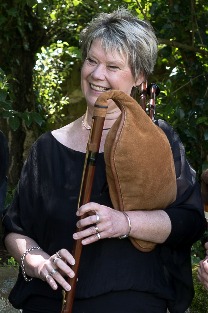
Grace Notes - Jane Moulder
Whilst writing this, I am looking out of my window at the snow falling down and thinking that it really would be great to go to Mallorca for the International Bagpipe Organisation conference in March! Sadly I can’t because of other commitments but whilst it may now be very short notice, if you can spare the time, then do see if you can find a last minute cheap flight as it really does look like bagpipe heaven to me! If you cannot make the pilgrimage to Mallorca, then I encourage you to do things a little closer to home to celebrate International Bagpipe Day on 10th March. The day is intended to help promote bagpipes and bagpiping to the world at large – so please do think about what you can do this year by getting out and about with your bagpipes and with International Bagpipe Day falling on a Saturday, there’s no excuses! Please post photographic and video evidence on the IBD Facebook page at https://www.facebook.com/internationaldayofthebagpipe/
If travelling to the Mediterranean for the company of fellow pipers is a bit out of reach, then hopefully Polesworth in Staffordshire certainly isn’t. This Chanter has full details of The Blowout 2018 and what a great year is in store. I’m something of a sucker for Italian music (both renaissance and traditional) and there’s a very big soft spot in my heart for the zampogna in particular. So I’m definitely going to be in heaven in June as the group ZampogneriA will be there together with bagpiping legend, Eric Montbel. There is plenty more besides and with a great range of workshops for both the beginner and the seasoned piper, there is something for everyone. So please make a note in your diaries and get the booking form returned as soon as possible. It does help the organisers’ planning if you don’t leave it until the last minute to book your place!
Looking back at early editions of Chanter, ‘letters to the editor’ formed a regular spot with some very interesting observations and thoughts being reflected. There is certainly less of that now (in fact, it’s very rare that I get anything submitted unsolicited!) so this edition of Chanter is particularly gratifying for me as I have received plenty of contributions from Society members and last edition’s article from Paul Roberts has generated some good feedback. Please do keep these coming and I hope that this edition’s examples will encourage others in the future. I am always very happy to receive ideas, feedback, suggestions – plus fully formed articles, of course! They don’t need to be long but certainly the more the merrier.
It has been some time since historical bagpipes have featured in Chanter, so Paul’s article was excellent in giving some thoughts to the early roots of the border bagpipe in England. In this edition, the timeline is stretching further back again, to the 16th century and further. Pablo Carpintero’s two part article on the very early development of the bagpipe is being traced through both linguistic and archaeological routes and part one, printed here, will start by concentrating on the rosca from the Iberian peninsula. There is also a review of a book by Society member, Michael Peter Vereno. The book is in German but there are plans to translate it into English. In the meantime, I hope the review will be able to give you an interesting perspective to the early development of the bagpipe and you will see, certainly by reading part 2 of Pablo’s article, that there is still much debate to be had.
I am very grateful to Nick Perry, who alerted me to some photographs on a website called Bulgarian Material Culture, which is part of the Endangered Archives Programme. There are some fascinating photographs on the site capturing a culture and way of life that could easily be lost forever. Amongst the images are these taken of a bagpipe maker in his workshop. The full selection can be viewed here: http://bit.ly/Chanter47
Historiae Animalium
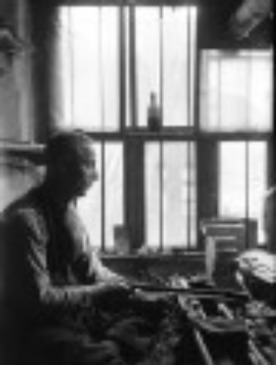
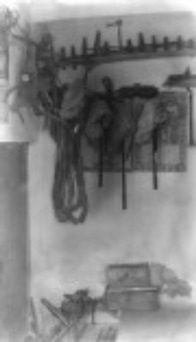

Hi Jane,
I turned up this image today, reprinted in Keith Thomas’ Man and the Natural World. It’s from Conrad Gesner’s Historiae Animalium published in Zurich 1551-8, and I’ve never seen it before. Hope it’s of use for Chanter (though I appreciate the image isn’t great quality). Interesting that pipers played for hard labour - that’s new to me.
Cheers, Andy Letcher
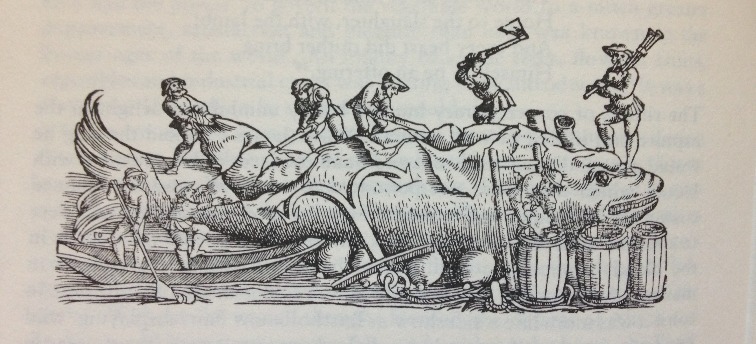
Letter of Wishes
Dear Jane
I imagine that all of our readers own one set of pipes and in some cases two or three sets. I personally have three, a set of Hummelchen pipes in D, a set of Shepherds mouthblown pipes in G and a set of Shepherds bellows pipes in G. So have they, I wonder, given a thought as to what will happen to them when they join the ranks of the pipers in the sky?
It would be awful for my expensive pipes to be put in an attic gathering dust. Although I haven’t got an attic, they could be put in a spare cupboard and just left. Even worse would be one’s relatives messing about with them until they get fed up with them and perhaps ruining them before discarding them.
Did you know that as an addition to your will you can write a “Letter of Wishes” so that items, such as bagpipes but cannot include money, can be left to whoever you feel will make good use of them. The “Letter of Wishes” can be altered at any time with recourse to a solicitor and without having to alter your will.
As regards my pipes, they are being left to where I feel they will be welcomed by either serious budding pipers or to someone who would like an additional set of pipes of a different type to what they already have. Do not ask me where or to whom as it may cause some embarrassment if my wishes were known.
However, I hope I have a few years left before my breath finally runs out!
Roger Fleming
Breadsall Priory Hotel
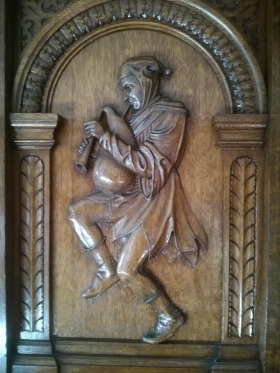
Hi Jane
I was recently on a course from work at Breadsall Priory Hotel near Derby. The hall of the hotel had a large fireplace with a carved wooden surround, on which were the two carvings, images of which I have attached.
Although the hotel is on the site of a medieval priory, the building itself is largely nineteenth century so I don’t imagine the carvings have any great age. However, I thought the readers of Chanter might find them interesting. They certainly cheered me up during quite a tough course!
Cheers, Rich Buxton
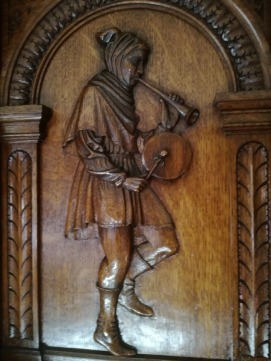
Symposion
Dear Jane
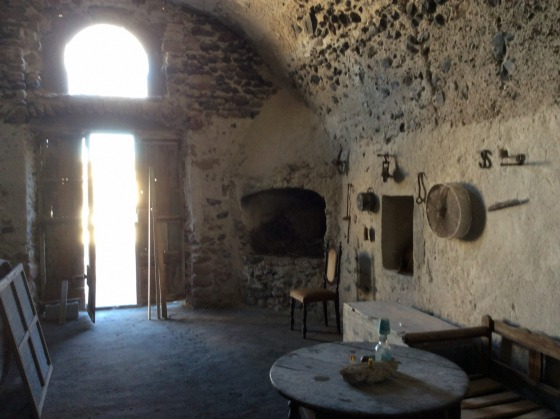
We would like to thank The Bagpipe Society again for your support for our project to bring the traditions of the past into the present, here on the beautiful island of Santorini: SYMPOSION – Music·Art·Mythology by La Ponta.
Thanks to your contributions through Indiegogo, additional offline donations, and our continued financial investment we will be opening the doors to SYMPOSION by La Ponta in the spring of 2018! We have already begun the refurbishment of the Saliveros Concert Hall, The Artisan’s Workshop and the exterior courtyard, including the Homeric Wine Cafe and the Mythological Botanical Garden, and will continue to work through the winter to get everything in place for the coming year.
In the spring we will begin a new year of concerts, musical presentations, and workshops, as well as our educational programs with local schools. Over the next few years, through our continued dedication and ongoing fundraising efforts, we hope to complete the refurbishment of the entire premises and realize our ultimate vision.
We hope to have you with us every step of the way. Our new website will be online very soon (https://www.symposionsantorini.com) and will provide all of the information you need for your future visits to SYMPOSION by La Ponta, as well as information on becoming a Friend of SYMPOSION, and on all of our future projects.
We’re so grateful for your support—thank you! Argy Kakissis and Yannis Pantazis
Lancashire bagpipes
Dear Jane,
When Chanter landed on the doormat this morning, I avidly consumed the article on historical English bagpipes by Paul Roberts. Particularly eye-catching to a historical piper looking for authentic repertoire was the reference to Thomas Bassett playing the Lancashire bagpipes in Shirley’s masque “The Triumph of Peace” in 1634, performed first at the Banqueting House in Whitehall and later at the Merchant Taylors’ Hall. A cursory search through Andrew Sabol’s compendium of Masque music revealed a piece entitled “The Jolly Shepherd” performed in “The Triumph of Peace”. What could possibly be more of a give-away? Here was a piece with a range of an octave and one from g to a’, in the three-finger key. This must surely be an (anti)-masque dance as performed by Thomas Bassett.
Regards, Alan Radford

Early Bagpipes
Dear Jane
It was very interesting to revisit the Paul Roberts article on early Bagpipes. Regarding the attribution to the Broadside Ballad illustration on page 18, of a broken set of “Lincolnshire” pipes, please see my article in a previous edition (Summer 2009), entitled The Downfall of Dancing. This broadside sheet was known to Samuel Pepys. The web link on the original article is now out of date. Please see http://ebba.english.ucsb.edu/ballad/21201/image
Best wishes, Dave Rowlands
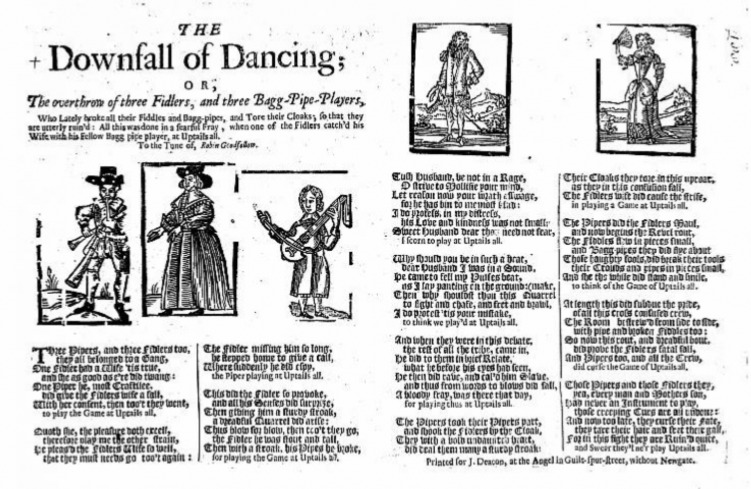
Lincolnshire, Lancashire and Scotch Bagpipes
Dear Jane
I enjoyed “Lincolnshire, Lancashire and Scotch Bagpipes” by Paul Roberts in the last issue of Chanter and would like to add a few points.
First, it is worth noting that Burton Agnes Hall is not in North Yorkshire as he cites, but in The East Riding of Yorkshire. (I commented on the Hall’s lady bagpiper carving in Bagsoc’s Newsletter of Summer 1999 when looking at evidence for playing of, or at least interest in, bagpipes in medieval and early modern East Yorkshire. James Merryweather then added further material in Chanter Autumn 2000.)
I make this point since Paul draws attention to evidence of pipes in counties adjacent to Lincolnshire. Well, East Yorkshire is adjacent, albeit across the Humber and it has enjoyed waterborne links with Lincolnshire and much further afield since pre-Roman times.
Further, Paul writes of “what is probably a keyed double-chanter bagpipe” illustrated on the Eglantine table in Derbyshire’s Hardwick Hall. It is years since I saw the table, but I do believe it actually depicts a single-drone, single-chanter bagpipe alongside a shawm with an oddly fitted fontanelle. Paul’s photograph seems to confirm my memory.
This instrumental coupling is consistent with a much older depiction in the Minster at Beverley, East Yorkshire’s county town and once great medieval port. High in the south-west corner of the nave are three fourteenth-century carvings of musicians: a bagpiper and two shawm players. Whereas the dozens of other musicians carved around the Minster seem randomly distributed, this group appears to be a credible trio, pitched approximately bagpipes-sopranino, shawms-soprano and alto. Unlike the other players, they wear swords and could just be an embryonic military band. Presumably they were definitely loud: a fourth figure beneath them has his hands over his ears.
Paul’s article also refers to the role of water traffic in music developments. The domestic accounts of Londesborough House (midway between York and Beverley) attest to this. In Tudor and Stuart times, before the fens north of the Humber were drained, small craft could make their way much closer to Londesborough than today. In 1614 a lute was repaired in London then brought by sea (and latterly land) to the House. Its owner, Sir, later Lord, Francis Clifford, was a great patron of music and drama. He welcomed many players to his house, including the waits of Beverley, York, Leeds and Doncaster. His accounts show he also occasionally employed pipers, On 2nd October 1594 Londesborough’s piper received 4d. The following August, Hindle, the piper from Skipton (a Clifford estate) was paid 5s. In January 1611 a duo playing drum and pipes got a shilling. While acknowledging James Merryweather’s wise caveat about interpreting “piper” as “bagpiper”, the fact that these pipers are singled out as soloists and a duettist, distinct from the ensembles, inclines me to strongly suspect they were bagpipers.
Here is one final point to intrigue Paul. Hedon, east of Hull, is a silted up Humber haven, once renowned for its great fairs. A ballad describing Hedon Fair is possibly eighteenth-century, given references in it to fashion items like bag wigs. One line depicts the scene thus: “Shrill whistles and trumpets, bag-pipes (sic) and gew-gaws.” One wonders: what sort of bagpipes? and where from? a local? a day-tripper from Lincolnshire? who knows?
Some references:
-
Londesborough House and its Community 1590-1643, Richard T. Spence, East Yorkshire Local History Society (Examination of the original records may settle the piper/bagpiper issue)
-
The Folklore of East Yorkshire, John Nicholson 1890
Best wishes, John Peel
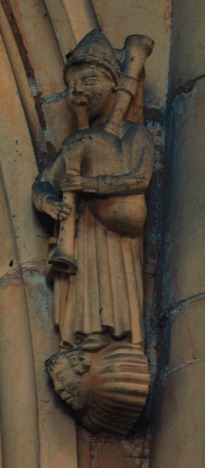
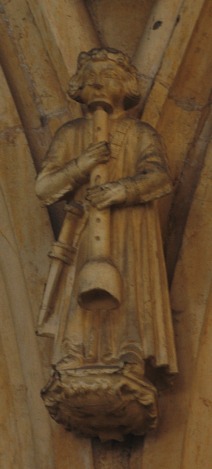
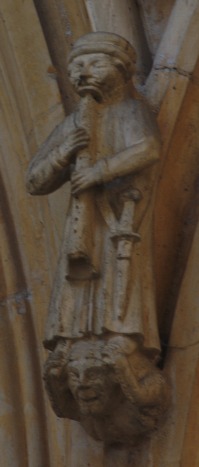
N.B. For the benefit of anyone going to see the Beverley Minster carvings, the disadvantage of those high up is difficulty seeing them in detail, especially in low light. The advantage is the fact they were high enough to escape the hands, hammers and chisels of the iconoclasts and restorers and are therefore a useful original source.
By International Bagpipe Organisation Moulder, Jane Trad
From Chanter Spring 2018.
- Data Processing Notice (GDPR)
-
@BagpipeSociety on X (formally known as Twitter)
-
TheBagpipeSociety on Instagram
-
 BagpipeSociety on Facebook
BagpipeSociety on Facebook
Something wrong or missing from this page? Let us know!
